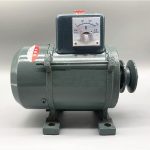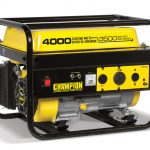Starting a new generator can be a straightforward process if you have the right tools and the knowledge. First, make sure the generator is on a level surface. It should also have adequate ventilation. Then make sure the fuel tank is full and the oil levels are filled according to the manufacturer’s instructions. Once the tank and oil levels are filled, you’ll need to connect the spark plug wire and make sure the choke is in the correct position.
Next, turn the generator switch to “on”, and pull the starter rope to start the engine. Once the engine has started, you’ll need to adjust the choke and the throttle to the correct settings. Finally, turn the switch off when the generator is not in use, and make sure to properly maintain the generator to ensure it runs safely and efficiently.
How do I start the generator?
Starting a generator can seem like a daunting task, but it doesn’t have to be! Here are the steps to get your generator running:
- Ensure the generator has fuel – either gasoline, diesel, or natural gas.
- Make sure the generator is on a flat, level surface.
- Check the generator’s oil to ensure it is at the correct level and is clean.
- Connect the generator to the electrical system it will be supplying, or plug in the load it will be powering.
- Locate the start switch on the generator, usually it will be a manual switch or a push-button electric switch.
- Turn on the fuel valve and the main switch, and then press the start switch. The generator should start and be ready to use.
How to turn on the generator?
Starting a generator can be quite an easy process. First, make sure the fuel tank is full and the oil level is sufficient. This is important to ensure the generator runs properly. Next, locate the generator switch. This switch will be a toggle switch and should be labeled “On” and “Off”.
Once the switch is located, make sure that the switch is “Off” before plugging in the generator. Finally, flip the switch to “On” and let the generator run for a few minutes. After a few minutes, the generator should be ready to use. Make sure to follow safety precautions while using the generator, such as using ear protection, keeping the generator away from flammable objects, and making sure the cords are properly grounded. With these steps, you should be able to successfully start the generator.
How to start a generator that has been sitting?
Starting a generator that has been sitting for a while can be a daunting task. First, inspect the generator’s fuel supply. Check to make sure that it is full and that there is no debris or dirt clogging the fuel line. Also, inspect the oil level and make sure that it is at the recommended level. Next, turn the fuel shutoff valve to the ON position.
Make sure that the battery is fully charged and that it is connected to the generator. Check to make sure that all the safety covers are in place and that all of the switches are in the “off” position. Now, turn the generator switch to the “start” position and pull the starter cord. If the generator does not start, check the spark plugs and make sure that they are in good condition. If the spark plugs are dirty or worn out, replace them. Once the generator is running, turn the switches on the generator to the “on” position. Check for any leaks or strange noises. If the generator does not seem to be running smoothly, turn it off and check for any problems. Finally, check the generator’s oil level every two hours and refill it as necessary. Before turning the generator off, make sure that the switches are in the “off” position and the fuel shutoff valve is turned to the “off” position. With proper maintenance, you can ensure that your generator will start and run reliably.
How to connect a generator to your home?
Starting a generator to connect to your home can be an intimidating task. However, it is quite simple if you follow the necessary steps. First, you will need to purchase the right type of generator. Make sure it is compatible with your home’s electrical system and all necessary safety features are in place. Next, you need to make sure the generator is located outside your home in a well-ventilated area.
This will help ensure that the exhaust fumes do not enter the home. Now you need to connect the generator to the power inlet box. This will be the main source of power for your home. You should use a heavy duty power cord to make sure you have a secure connection. Once the generator is connected to the power inlet box, you need to make sure the power switch is in the “off” position. This will help protect any appliances or devices that are connected to the generator. Finally, you should test your generator to make sure it is functioning properly. Once you have completed these steps, you are ready to start the generator and enjoy the power it provides to your home.
How do you Power Your House with a generator?
It can also be used to supplement your existing home’s power supply when needed. Before you start a generator, there are several important steps to take. First, you must choose the right type of generator for your home. Depending on your needs, you may need to consider the size and power output of the generator, as well as the type of fuel it uses. Once you’ve selected the right generator, you’ll need to install it correctly.
This means locating it in a safe and secure area, making sure the generator is properly ventilated, and that all electrical connections are safe and secure. Once the generator is installed, you’ll need to start it up and connect it to your home’s power supply. This includes connecting the generator to an appropriate transfer switch, which will provide power for your home. Finally, you’ll need to test the generator to make sure it is working properly and safely. This includes checking for proper voltage output, fuel levels, and ensuring that all connections are secure. With a properly installed and tested generator, you can rest assured your home’s power supply is safe and reliable.
Why wont my portable generator start?
If your portable generator won’t start, it can be very frustrating. There are a few common causes that can prevent your generator from starting. First and foremost, make sure you have enough fuel in the tank, or that the fuel valve is open and the fuel line is not clogged. Secondly, check the spark plugs and clean or replace them if necessary. Thirdly, check the oil level and make sure it is not too low.
Fourthly, check the battery and make sure it is not too low or dead. Lastly, check the choke and make sure it is in the correct position. If these steps don’t help, it could be a more serious issue involving the engine or the generator itself. In this case, it may be necessary to take it to a professional for a full inspection.
Do I plug the generator in before I start it?
When starting a generator, it is important to consider whether or not to plug it in before starting it. Depending on the model of your generator, some require it to be plugged in to a power outlet before starting the engine. This is because the generator needs to be connected to a power source before it can produce an electrical current. It is also important to check the owner’s manual to determine if your model requires the generator to be plugged in or not. This is to ensure that the generator is working properly and to avoid any potential damage that can occur if the generator is started without being attached to a power source.
If your generator does not need to be plugged in prior to starting, then you can start it without any issues. Once the generator is running, you can then plug in any electrical appliances you need to power. It is important to remember that the generator should not be connected to a power outlet while it is running. This is to avoid any potential accidents or damage to the generator itself. Therefore, it is important to check the owner’s manual to determine if the generator should be plugged in prior to starting it and to make sure that the generator is not connected to a power outlet while running. This is to ensure that the generator is functioning properly and avoiding any potential accidents.
Can I just plug a generator into an outlet?
Starting a generator can be a tricky task. It is important to know the proper steps for safely operating a generator. One common question is: can I just plug a generator into an outlet? The answer to this question is generally no, because of the potential risk of overloading the circuit or causing an electrical surge. Generators must be connected to an outlet using a transfer switch or an interlock device. This switch will allow you to safely and easily connect the generator to your home’s circuit breaker panel.
In addition to using a transfer switch, it is important to make sure the generator is properly grounded. This will reduce the risk of electric shock. Before connecting the generator to your home, you should also make sure it is properly sized for your home’s electrical needs. If the generator is too small, it could overload the circuits and cause a fire. To ensure your safety and the safety of your home, make sure to follow all the necessary steps for properly starting a generator. Don’t take any risks–always use a transfer switch or interlock device when connecting a generator to an outlet.
Can you leave a generator plugged in all the time?
It is important to understand the best practices for operating a generator safely and efficiently. One of the most common questions people have is whether you can leave a generator plugged in all the time. The answer is no, you should not leave a generator plugged in all the time. Generators use fuel to generate electricity, and if it is left plugged in for too long, it can overheat and cause damage to the machine and the property connected to it. Not to mention, leaving a generator running for too long can lead to unsafe levels of carbon monoxide buildup.
To avoid these issues, it is recommended to only use a generator for short periods of time and to follow the manufacturer’s instructions for how long you can safely operate the generator. If you need to leave it on for an extended period, be sure to set a timer and turn it off after your desired time has elapsed. Additionally, you should always ensure that your generator is in a well-ventilated area and that it is at least 20 feet away from any windows or other openings. Finally, when you are done using the generator, be sure to turn it off, unplug it, and let it cool down before storing it. This will help maintain the efficiency and longevity of your generator, ensuring that it will be ready when you need it. In short, it is not recommended to leave a generator plugged in all the time. Be sure to follow the manufacturer’s guidelines and use it for short periods of time, and never leave it running for too long. Additionally, be sure to let it cool down before storing it for future use.






